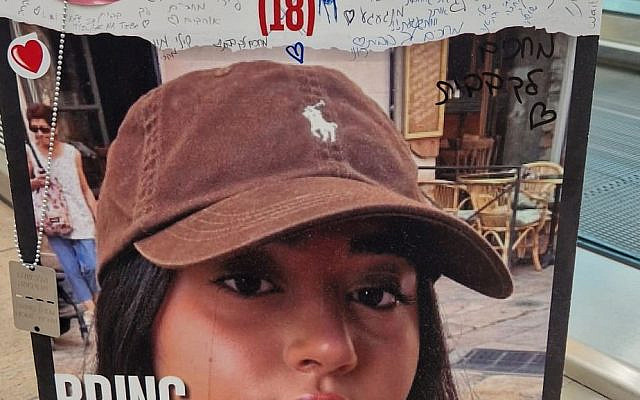Pictures that are worth a million words: A Londoner visits Hostages Square

Dateline: Thursday 21st March 2024 – Tel Aviv, outside the Museum of Modern Art
My wife and I arrive at Ben Gurion airport in Israel on the evening of 20th March. As we walk down the familiar runway towards passport control the faces of the hostages stare back at us from the ground, in reality they are below the ground right now.
We have been here before, at Chanuka. We hoped not to have to see them here again, but we knew what to expect.
Normally, there is a stampede down the terminal runway; to get in the queue, to get past the booth with passport stamped, the little blue slip enclosed, to get to the carousel, get our luggage, get on the train to Modiin, get safely to our son’s apartment – to safety, to sanctuary.
But those faces, how can we just pass them by? They are appealing, pleading to us – don’t pass by, don’t leave us behind – bring us home! We search for Liri, Liri Albag whom we have adopted at Belmont United Synagogue; we know her face from the picture on her seat in our Shul. We find her, others have too. They have left messages to her and the other hostages. “We’re sorry… we won’t forget you… don’t lose hope… we love you.” What else can we do?
– – – – – – –
Thursday morning, 10.30. We are at Kikar HaChatufim (Hostages Square). On the way from Tel Aviv HaShalom station, a mere 20-minute walk, photos of the Chatufim line the streets on buildings walls, on billboards, on posts. Liri is in evidence everywhere, prominently on the street fronting the Sarona square. We figure that those who feature most often are themselves Tel Avivi. Their families and friends want everyone who arrives there to know about them. Their names as well as their faces are familiar to us now – Liri, Eden Yerushalmi, Daniela Gilboa, Shlomo Mantzur (85) Or Levy, Ilan Weiss, little Kfir Bibas.
Next to a building which displays Israel’s declaration of independence, with facsimiles of the signatures of David Ben Gurion and other great leaders from Israel’s past, another building displays a shorter, but equally urgent message, “Bring Them Home Now” as if to try and invoke the spirit of Ben Gurion to come to Israel’s aid at its time of greatest need since 1948.
It is quiet on the Kikar, just a few visitors around. Tables and stalls are being set up; open-sided tents with hosts to welcome us in, like Abraham welcoming the visiting angels. (Are we meant to be angels?) Within an hour the Kikar is heaving, as coachloads mostly of school children, students and IDF trainees are disgorged and impromptu lectures and presentations are happening all over the square. But for now, it is just quiet and really you want quiet when you are confronted with the sight of others’ misery and despair.
“A picture is worth a thousand words” (Fred R. Barnard). Millions of words can be said about the Chatufim, and about all who perished on October 7th and who have fallen since – their brutal, violent abduction, their plight in captivity, the callous disregard of their captors.
Millions of words; for Kikar Chatufim indeed has thousands of pictures – children’s messages and drawings from around the world, images, paintings, cartoons, inscriptions, carvings, even decorated padlocks and piano.
And of course, the table. The table which at one end is laid like a banquet waiting for the guests who cannot be present, their pictures at each seat. The other end depicts the horrors being endured daily – the empty bottles and baby dummies casually scattered, the grime and the filth. These guests’ faces have been blacked out, representing the ones for whom there will be no banquet.
There is no need for words, the pictures tell it all. “The words will never show, the you I’ve come to know,” David Gates wrote and sang so poignantly.
We walk down the reconstruction of a Gaza tunnel like some macabre theme park exhibit, the recorded sounds of chains rattling, boots banging on metal (in my imagining, the jackboots and associated sounds evoke a 1940’s death camp). Visitors have left messages on the tunnel walls, too.
– – – – – – –
We are welcomed into the Nova tent (Nova, the music festival where 369 young people were murdered) by Nili Bresler, a tiny grey-haired lady who lives in Ramat Gan, less than a mile away from Kikar Chatufim. She lived as a volunteer on one of the southern Kibbutzim and regards it as her “home.” She comes to the square most days to tell the victims’ stories to visitors, so that their stories at least won’t die.
Nili is a veteran campaigner. She is pro-democracy through and through, and she understood how Israel was being torn apart. The day before October 7th, she blogged in the Times of Israel, presciently “Yes to Civility, No to Civil War.” Now like millions of Israelis, her focus is on a different cause – bringing them home.
Nili looks and is exhausted; from the countless hours spent at the Kikar, from the torment and mental anguish. She epitomizes the whole of Israel, a country desperate for news of loved ones, neighbors, fellow citizens, Yehudim and others. May they soon be answered.
Nili tells us more about Liri and her family. Liri was not at Nova, she was in uniform on guard on the southern border, just 18 (her 19th birthday was spent in captivity on 4th February).
https://www.timesofisrael.com/liveblog_entry/mother-of-hostage-who-turns-19-today-you-are-so-missed-it-hurts-my-heart/
Photographs of soldiers are less in evidence than civilians on orders of the IDF. But Liri’s presence is everywhere both outside and in the square. Her family members join the jostling crowds every day at 5.30 pm without fail; to talk about Liri, to plead with their government, literally to will her back into their arms.
– – – – – –
11.45 – and we are done, in every sense of the word. We can absorb no more. We prepare to leave.
We notice those coachloads of youngsters milling around, some waving Israeli flags others sporting T-shirts, ribbons and mementos. They are respectful, but they are also young. It is like being on a Poland trip in your own country.
We leave to find some sanctuary, somewhere, anywhere – but where to go? To the beach or into town? Choices, choices. We settle on Sarona, an oasis of calm amidst Tel Aviv’s high-rise buildings and traffic choked streets, because we like it there, also it is nearby. We exercise our choice; choice which is denied to the Chatufim.
Back at our apartment, there is a smart TV. One of the Israeli channels has loaded up video shorts of about 3 minutes each, for each of the hostages. We search for Liri’s and we watch; her two older sisters are talking and showing images and clips of little Liri, happy Liri, party girl Liri. We don’t know everything they are saying but we understand. One of her sisters’ sheds tears, and so do we. It is heartbreaking.
– – – – – – –
Friday night: 22nd March – Maariv service in Modiin
It is the start of the Purim weekend of festivities at our son’s synagogue, Kehillat Darchei Tzion. One of the senior members, Doron, a talented musician and singer in his 30s, gets up to lead the prayers for Kabbalat Shabbat (welcoming Shabbat). Doron’s 23 year-old brother perished on the frontline just two months before. Doron sings with gusto and soon has everyone dancing down the aisles as if at a simcha, putting aside momentarily the mourning and anguish overhanging this year’s Purim festival. My son says, no one will argue with Doron – if he wants to dance, we will dance.
– – – – – –
Tuesday 26th March – Hof HaCarmel (Haifa beach)
After our Purim costumes are put away, we go to Haifa as we do every trip to visit my Aunt Helga, my late mother’s younger sister, who PG will be 98 in May. She lives on Mount Carmel in the same flat where she and her husband set up home the year after the State of Israel was born. Helga has seen and heard it all before, but not what is going on now. She watches the news channel from Japan, “it tells me more about what is happening in the world than BBC, CNN or Channel 7 (Israel national news),” she explains.
Our time-honored ritual is to take an early morning train from Modiin to the Hof HaCarmel station (1 hour 45 minutes) and stroll on the Tayelet at the beach before getting the no. 3 bus which chugs up the Carmel slopes to where my aunt lives, on a street overlooking Haifa’s continuously encroaching harbor. The wind is biting, more like Bournemouth in November.
Even at the beach, there is no escape from “the message.”
Wednesday 27th March – Ben Gurion airport
All too soon, it is time to depart. Time for one last walk with our grandchildren to their schools, and goodbye hugs and kisses until next time. The weather has been fresh, the summer we have been waiting for all week arrives the day we depart. Yet one more metaphor for the state Israel is in – waiting… waiting!
Through security and on the runway, there is one more person to whom we must say our goodbyes. Liri’s image is adorned with many messages, including one left by a previous visitor from Belmont’s community. We simply add our initials and a heart. There are no more words, except…we’re sorry, we won’t forget you.
“Then one by one the stars would all go out
Then you and I would simply fly away.”



